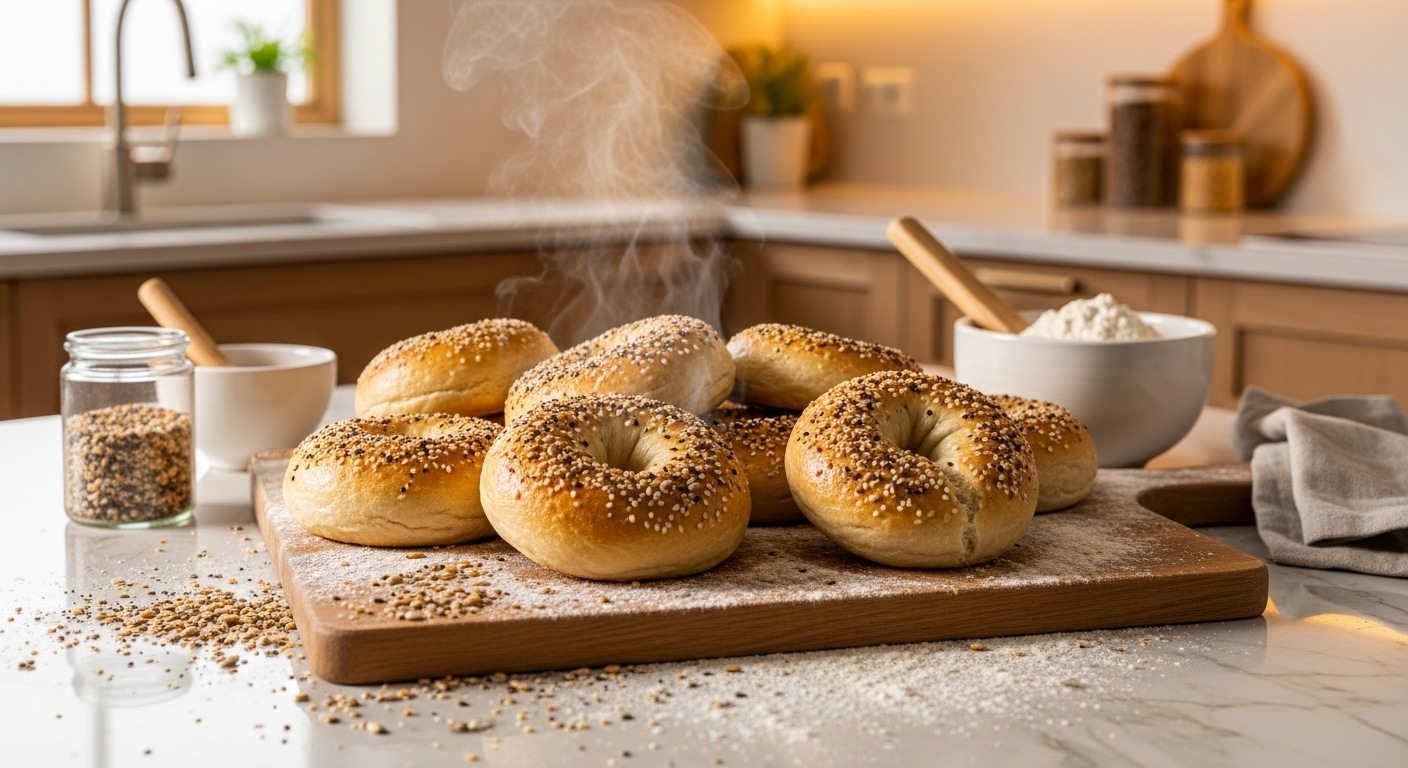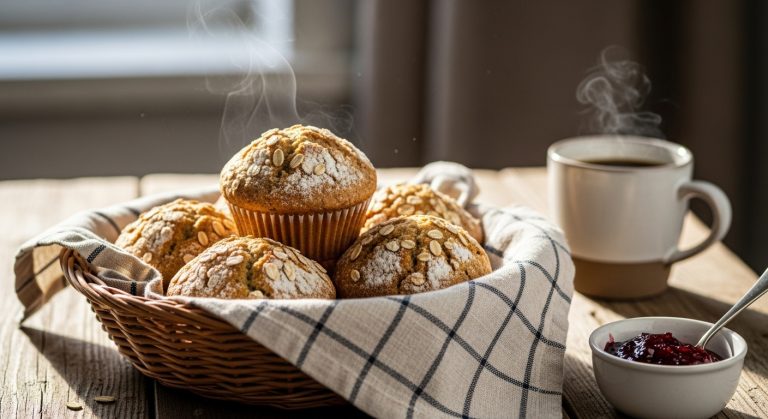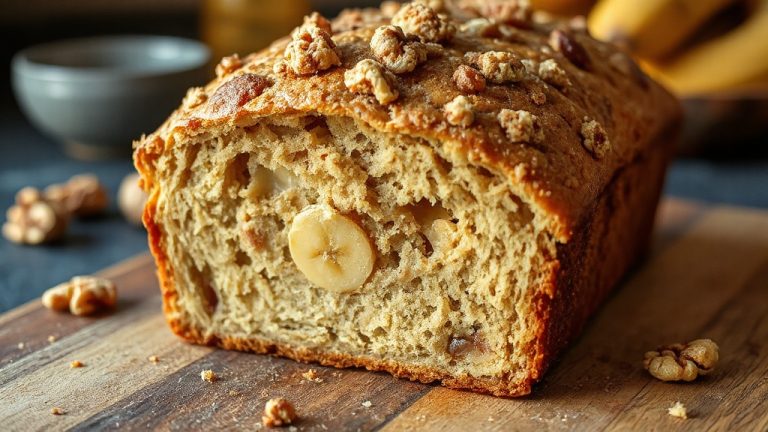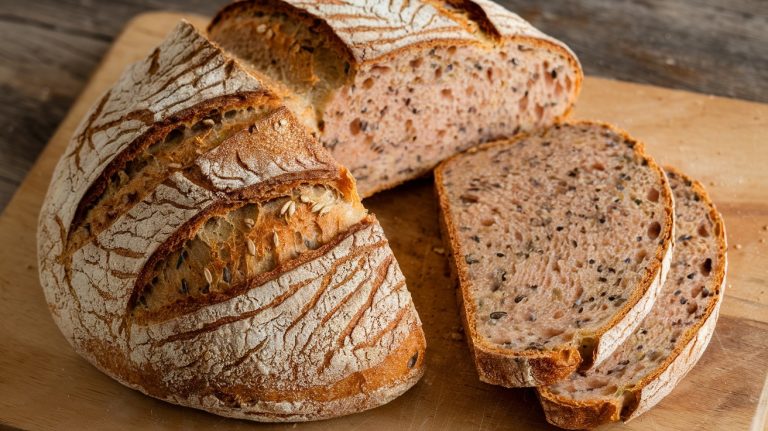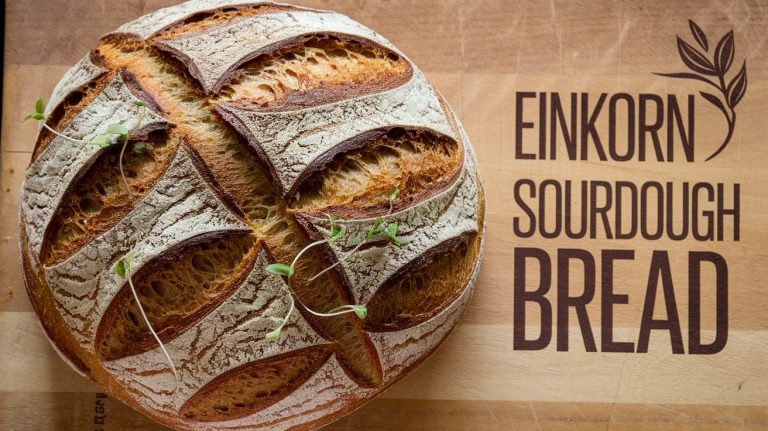Sourdough Bagel Recipe: Crispy Outside, Chewy Inside
To make irresistible sourdough bagels, start with high-protein flour and a bubbly, active starter. Mix the ingredients until the dough is soft and tacky, then knead for a chewy texture. Let it ferment, then shape your bagels and boil them briefly for that perfect crust.
Finally, bake at 425°F until golden brown. Customize with a variety of toppings and flavors that suit your taste. Stick around to discover more tips for perfecting your bagel-making skills.
Key Takeaways
- Choose high-protein flours like bread or hard red wheat for a chewy texture, and experiment with whole wheat or rye for enhanced flavor.
- Mix sourdough starter, water, honey, and salt before gradually adding flour to achieve a soft, tacky dough.
- Allow a bulk fermentation of 4-8 hours, folding the dough halfway through to strengthen gluten and improve flavor.
- Boil bagels for 30 seconds to 1 minute per side for a chewy crust, adding baking soda for a darker finish.
- Bake at 425°F for 20-25 minutes until golden brown, and customize toppings like sesame seeds or everything seasoning for added flavor.
Complete Sourdough Bagel Recipe Guide
| Step | Ingredients / Action | Details | Tips & Notes |
|---|---|---|---|
| Starter | Active sourdough starter | 100g (bubbly, fed) | Use a healthy starter for best rise |
| Liquid | Water | 250g (lukewarm) | Adjust based on flour absorption |
| Sweetener | Honey or brown sugar | 1–2 tbsp | Adds sweetness & shiny crust |
| Seasoning | Kosher/sea salt | 8g (1 ½ tsp) | Balances flavor & controls fermentation |
| Flour | Bread flour (high protein) | 400–450g | For chewy texture; mix with whole wheat/rye for flavor |
| Mixing | Combine starter, water, honey, and salt | Add flour gradually | Aim for soft, tacky dough |
| Kneading | By hand 5–7 min / mixer 6–7 min | Develop gluten | Don’t over-knead or dough will tighten |
| Bulk Fermentation | Cover dough & let rise 4–8 hrs | 78–80°F ideal | Fold once midway for strength |
| Shaping | Divide & roll into logs or balls | Create center hole | Ensure hole is larger than final size |
| Boiling | Water + 1 tbsp baking soda | 30 sec–1 min per side | Longer boil = chewier crust |
| Baking | Preheat 425°F | 20–25 min until golden | Bake immediately after boiling |
| Toppings | Sesame, poppy, everything mix, cheese, cinnamon sugar | Sprinkle before baking | Customize to taste |
| Storage | Airtight container | 2–3 days fresh / 3 months frozen | Toast for best flavor after freezing |
Ingredients Needed for Sourdough Bagels
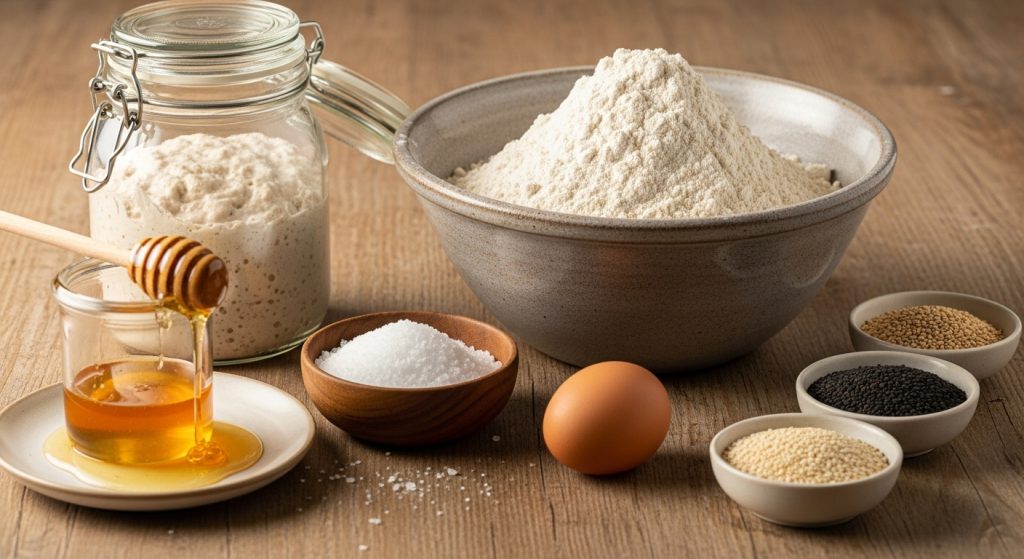
When you’re ready to make delicious sourdough bagels, you’ll need a variety of ingredients that work together to create that perfect chewy texture and rich flavor. Start with sweeteners like honey or brown sugar, which add a touch of sweetness and help achieve a shiny crust.
Don’t forget kosher or sea salt, indispensable for seasoning and controlling yeast activity. Water plays a vital role too; it balances dough stiffness and influences fermentation speed. Proper proofing time is critical to ensure your bagels are light, chewy, and flavorful. Baking soda in the boiling water helps form that signature chewy crust.
For a glossy finish, consider an egg wash. Ultimately, toppings like sesame seeds or poppy seeds can elevate your bagels further. Gather these ingredients, and you’re all set to begin your baking adventure.
Choosing the Right Flour and Starter
Choosing the right flour and starter is essential for crafting the perfect sourdough bagel. You’ll want to focus on high-protein flours like bread flour or hard red wheat, which provide the gluten necessary for that chewy texture.
Whole wheat flour adds flavor and nutrition but should be balanced with bread flour to maintain the dough’s strength. For your starter, consider using whole wheat or rye flour; they enhance microbial activity and boost flavor complexity.
While all-purpose flour is an option, it lacks the nutrients needed for a robust starter. Additionally, using freshly milled flour can significantly improve the flavor and nutritional profile of your bagels.
The choice of flour can impact yeast activity and ultimately the texture of your bagels, so experiment with blending flours for a unique taste, but always prioritize those with higher gluten content to ensure your bagels hold their shape and deliver that delightful chew.
Dough Preparation and Mixing Techniques
To achieve the perfect sourdough bagel, mastering dough preparation and mixing techniques is essential. Start by incorporating your sourdough starter, water, honey, and salt in a bowl or mixer. Gradually add flour in portions to control dough stiffness, mixing until you have a soft, tacky dough.
If using a stand mixer, use low speed for 3-10 minutes. Proper kneading duration is approximately 30 minutes by hand, ensuring a smooth and pliable dough.
| Step | Description |
|---|---|
| Initial Mixing | Combine ingredients before adding flour. |
| Gradual Flour Addition | Add flour half a cup at a time. |
| Dough Consistency | Aim for a soft, tacky texture. |
| Cover During Fermentation | Prevent drying with a wet towel. |
Kneading for Chewiness and Structure
Kneading plays an essential role in achieving the ideal chewiness and structure of sourdough bagels, as it develops the gluten network necessary for that distinctive texture. For about 5-7 minutes, you’ll want to push, fold, and stretch the dough, creating a smooth and elastic consistency.
Be cautious, though; over-kneading can tighten the dough, leading to a tougher bite. Hand kneading is often preferred, allowing for better control and less heat generation. If using a stand mixer, a dough hook can achieve similar results in 6-7 minutes at low speed.
Remember to incorporate rest periods to relax the gluten, making it easier to shape your bagels while maintaining that delightful chewiness. Additionally, using active sourdough starter ensures a good rise and enhances the chewy texture of your bagels.
Bulk Fermentation and Flavor Development
As the dough undergoes bulk fermentation, it transforms into a living entity, full of potential and flavor. This vital stage typically lasts 4 to 8 hours, depending on your kitchen’s temperature. Aim for around 78-80ºF to keep your yeast happy and active.
You’ll notice the dough doubling in size, becoming soft and puffy, with delightful bubbles forming. A single fold halfway through will strengthen gluten, enhancing its structure. During this time, the natural yeast and bacteria work their magic, producing carbon dioxide and organic acids that deepen flavor and improve shelf life.
Optimal temperature is essential for sourdough yeasts to thrive. Just be careful—over-fermentation can lead to sourness or a slack texture, while under-fermentation results in dense, bland bagels. Trust the process, and enjoy the transformation!
Shaping Your Bagels
Once your dough has completed its bulk fermentation, the exciting process of shaping your bagels begins. Start by dividing the dough into equal pieces, and pat each into a wide log, avoiding tapered ends. Roll the logs under your cupped hands to elongate them to about 6 to 8 inches, then let them rest seam side down for 30 minutes.
For the traditional ball and hole method, shape a round, poke a hole in the center, and twist to enlarge it. Remember, it should be larger than your final size! To ensure proper dough structure, it’s important to let the preshaped dough rest before final shaping. A well-shaped bagel retains its moisture and flavor during baking, enhancing the overall texture of your finished product.
If you prefer a more polished look, try the log folding and pinching technique. Whichever method you choose, sealing the bottom is essential for maintaining that perfect round shape.
Boiling for Texture and Crust
Boiling your bagels is a crucial step that transforms them from simple dough into the chewy, glossy treats we crave. Typically, you’ll want to boil your bagels for 30 seconds to 1 minute per side, depending on how dense and thick you want the crust.
If you prefer a chewier texture, go for a longer boil; a shorter boil preserves more oven spring for a lighter bagel. Adding baking soda to the water raises the pH, promoting a darker, shinier crust.
Proper second rise ensures the bagels are ready for boiling and baking, enhancing their final texture. Remember to boil in small batches to avoid overcrowding, using a slotted spoon to flip them gently. This process gelatinizes the starches, ensuring your bagels develop that characteristic glossy sheen and delightful chewiness.
Baking to Perfection
To achieve bagels that are both beautifully golden and perfectly chewy, you need to pay close attention to the baking process. Preheat your oven to 425°F (218°C) and verify the rack is in the center for even heat. Bake your bagels for about 20 to 25 minutes until they’re golden brown.
Timing is essential; baking immediately after boiling prevents sogginess and preserves the desired texture. Additionally, using a bubbly, active sourdough starter enhances the flavor profile of your bagels, making them even more delicious.
| Step | Temperature | Duration |
|---|---|---|
| Preheat Oven | 425°F (218°C) | – |
| Bake Bagels | 425°F (218°C) | 20-25 minutes |
| Check Doneness | Golden Brown | – |
Following these steps guarantees a perfect crust and chewy interior, making your sourdough bagels irresistible.
Enhancing Flavor With Toppings
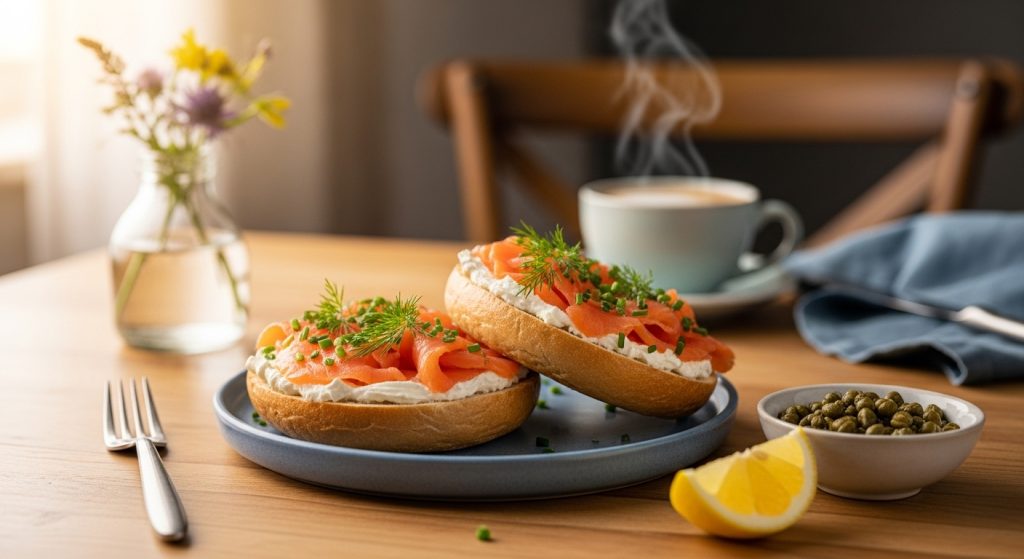
While the baking process is essential for achieving the perfect bagel, the toppings you choose can elevate your creation to new heights. Consider classic options like sesame or poppy seeds for a subtle crunch.
For a bold twist, sprinkle on everything bagel seasoning, combining various flavors in one bite. Incorporating active fermentation into your dough enhances the overall flavor profile as well.
If you crave richness, shredded cheddar or asiago cheese melts beautifully atop your bagel, creating a savory crust.
For something sweet, try a cinnamon sugar mixture, adding a delightful crunch and warmth; the cinnamon-sugar crunch topping brings an extra layer of flavor to your bagels.
Don’t forget innovative toppings like avocado slices or smoked salmon and cream cheese for a gourmet touch.
Each topping enhances your bagel’s flavor, making every bite a delicious experience you won’t forget.
Variations and Customization Options
When it comes to customizing your sourdough bagels, the possibilities are endless. You can experiment with unique topping combinations, adjust sweetness levels for that perfect bite, or even swap out different flours to create your ideal texture.
Incorporating flavor variations like jalapeño cheddar or cinnamon raisin can also enhance your bagels’ appeal and make each batch a delightful adventure. Each tweak not only personalizes your bagels but also elevates their flavor, making every batch a delightful adventure.
Remember, using nutritional information from cookbooks can guide you in making healthier ingredient choices.
Unique Topping Combinations
Exploring unique topping combinations for your sourdough bagels can elevate your baking experience and delight your taste buds. By mixing flavors and textures, you can create a bagel that’s truly special. Here are some ideas to inspire your next batch:
- Everything Bagel Seasoning: A classic mix of sesame, garlic, onion, and poppy seeds for a savory crunch.
- Hot Honey with Chili Peppers: Adds a sweet heat that’s irresistible.
- Cheddar and Banana Peppers: A spicy tang that pairs beautifully.
- Sun-Dried Tomato and Basil: Infuses Mediterranean flair into every bite, reminiscent of flavored sourdoughs that provide diverse taste profiles.
- Garlic and Onion Flakes: Boost aroma and savory goodness on top.
Incorporating different unique add-ins can enhance your bagels’ flavor profile and make them even more exciting. Experiment with these toppings, and watch your sourdough bagels transform into a delightful treat!
Sweetness Alterations
Adjusting the sweetness of your sourdough bagels opens up a world of flavor possibilities, allowing you to tailor each batch to your taste. You can experiment with brown sugar for a mild caramel note or granulated sugar to balance the tang.
For an extra touch, add honey or molasses to the boiling water; they enhance the crust’s color and provide subtle sweetness. Additionally, consider the timing of your ingredient additions, as some can impact the dough’s rise during fermentation.
Incorporate sweet inclusions like chocolate chips, raisins, or blueberries for delightful bursts of flavor. If you want a warm spice profile, mix in cinnamon.
Just remember, sweetness impacts yeast activity and fermentation, so tweak your amounts carefully to maintain that perfect rise and texture while enjoying your personalized sourdough creation!
Flour Variations
Elevating your sourdough bagels goes beyond sweetness; the choice of flour can dramatically influence flavor, texture, and overall enjoyment. Experimenting with different flours lets you customize your bagels to perfection.
Here are some variations to consider:
- Bread Flour: High protein content for that classic chewy texture, as gluten formation is essential for structure.
- Whole Wheat Flour: Adds fiber and a nutty flavor without sacrificing structure.
- Rye Flour: Introduces depth and enhances sour notes.
- Ancient Grain Flours: Unique flavors, best blended with stronger flours.
- All-Purpose Flour: A softer option, yielding less chewiness.
Frequently Asked Questions
Can I Use Instant Yeast Instead of Sourdough Starter?
Yes, you can absolutely use instant yeast instead of sourdough starter! It’ll give you a quicker rise, letting you whip up your dough in about 90 minutes. Just mix the instant yeast directly with your dry ingredients; there’s no need for proofing.
However, keep in mind that the flavor and texture will differ. Your bagels may lack that signature sour tang and complexity that comes from the slow fermentation of sourdough.
How Long Can I Store Baked Bagels?
Ever wonder how to keep your bagels fresh? You can store freshly baked bagels at room temperature for about 2 days without preservatives.
If you’ve got bakery sourdough bagels, they last 3-4 days in an airtight container.
Remember, refrigeration might extend their life to a week, but it can make them stale quicker.
Freezing is your best bet for long-term storage, keeping them fresh for up to 3 months.
What Should I Do if My Dough Is Too Sticky?
If your dough’s too sticky, start by adding flour gradually, just a tablespoon at a time, until it firms up. You can also chill the dough to make it easier to handle.
Using wet hands helps manage stickiness, and consider incorporating a bit of oil for better texture.
Finally, make sure you’re measuring your ingredients accurately to maintain the right water-to-flour ratio, preventing future stickiness issues.
Can I Freeze Unboiled Bagels for Later Use?
Yes, you can freeze unboiled bagels, but it’s not the most common practice. Freezing them without boiling may alter their texture and rising ability.
If you choose this method, be prepared to thaw and then boil them before baking to achieve that classic bagel chewiness.
For best results, wrap them tightly to prevent freezer burn.
Remember that their quality mightn’t match fully baked bagels. Enjoy experimenting.
How Do I Know When My Bagels Are Fully Baked?
When it comes to bagels, they’re like a perfectly tuned guitar; each note matters! You’ll know your bagels are fully baked when they’re golden brown on top, with a firm crust that springs back when pressed.
Toppings should be toasted, and tapping the bottom should produce a hollow sound.
Check the interior for a chewy texture, ensuring it’s moist but not gummy.
Let them cool on a wire rack for the best results!
Turn Every Morning Into a Treat With Homemade Sourdough Bagels
Once you’ve mastered these sourdough bagels, you’ll find yourself sharing them at family brunches or cozy gatherings, creating memories that linger long after the last bite. Imagine a sunny Sunday morning, laughter filling the air as loved ones savor the warm, chewy bagels, each topped with their favorite spreads.
You’ve crafted not just a delicious treat, but a centerpiece for connection and joy. So roll up your sleeves and let your sourdough journey bring people together.

